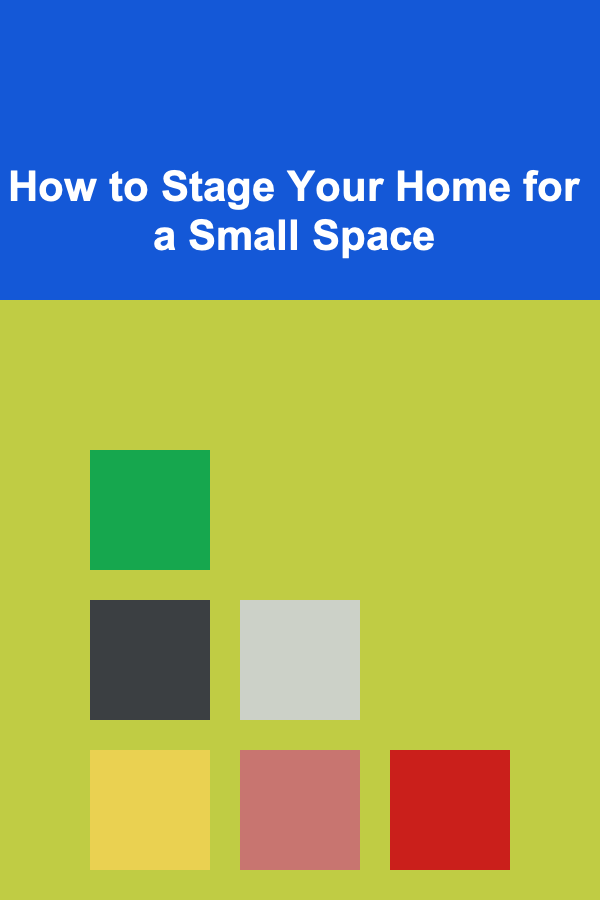
Essential Tips for Growing Your Own Fruits and Vegetables in Small Spaces
ebook include PDF & Audio bundle (Micro Guide)
$12.99$8.99
Limited Time Offer! Order within the next:

Growing your own fruits and vegetables is a rewarding and sustainable way to improve your diet, reduce your carbon footprint, and enjoy the satisfaction of nurturing your own food. However, limited space doesn't have to be a barrier to creating a productive garden. Whether you have a small balcony, a tiny backyard, or even just a sunny windowsill, it's entirely possible to grow your own crops. With the right approach, small spaces can yield a surprising amount of produce.
In this guide, we'll explore actionable tips and strategies for successfully growing fruits and vegetables in small spaces.
Choose the Right Plants for Small Spaces
The first step in growing a productive garden in a limited area is selecting plants that thrive in small spaces. Some plants are naturally suited to container gardening or compact growing environments, making them perfect for small areas.
Actionable Tips:
- Opt for Dwarf and Compact Varieties: Many fruits and vegetables come in smaller, space-saving varieties that are perfect for small gardens. Look for dwarf versions of common plants such as tomatoes, peppers, or fruit trees. These varieties are bred specifically to grow in containers or small areas while still producing a generous harvest.
- Leafy Greens: Lettuce, spinach, kale, and arugula are ideal for small spaces because they grow quickly, don't require much room, and can be harvested multiple times. They also tend to grow well in containers or raised beds.
- Herbs: Herbs like basil, cilantro, parsley, mint, and thyme grow well in small spaces and even on windowsills. Many herbs are great for container gardening and can be grown indoors during colder months.
- Root Vegetables: While some root vegetables like carrots and beets need deeper containers, they can still thrive in small spaces. Look for shallow-rooted varieties if you're restricted on depth.
- Vertical Gardening Options: Plants like cucumbers, tomatoes, peas, and beans can be grown vertically using trellises or other supports, saving precious ground space. You can train these plants to grow upward rather than outward, which helps you maximize your space.
Utilize Vertical Space with Trellises and Supports
When space is limited, it's essential to think vertically. Growing plants up rather than out can significantly increase the amount of usable space in your garden.
Actionable Tips:
- Install Vertical Supports: Trellises, cages, and stakes are perfect for vining plants like cucumbers, peas, and beans. These structures allow plants to climb upward, freeing up space for other crops.
- Use Hanging Planters: Hanging baskets and containers can be used to grow herbs, strawberries, and flowers, taking advantage of overhead space that would otherwise go unused.
- Vertical Planters and Wall Gardens: You can also use vertical planters or wall-mounted garden systems. These can be installed against fences or walls to create a compact yet productive garden area.
Maximize Container Gardening
Container gardening is one of the most effective ways to grow plants in small spaces. With containers, you can grow a variety of fruits, vegetables, and herbs even if you don't have a traditional garden bed. Additionally, containers offer flexibility, as they can be moved around to optimize sunlight exposure and are easier to manage.
Actionable Tips:
- Choose the Right Containers: Select containers that are the right size for the plants you want to grow. Larger containers are necessary for larger plants like tomatoes or peppers, while smaller ones are sufficient for herbs and greens. Make sure your containers have proper drainage to prevent waterlogging.
- Use Self-Watering Containers: Self-watering planters are a great investment for small-space gardening. These containers reduce the frequency of watering, which is especially useful if you have a busy schedule or live in a hot climate.
- Group Containers Together: Placing containers close together can create a micro-environment, trapping moisture and heat, which is beneficial for plant growth. You can also use containers to create different garden "zones," each with a mix of plants suited to specific needs.
Choose the Right Soil and Fertilization
The success of your plants depends on the quality of the soil they're growing in. In small spaces, where soil may be limited or of poor quality, it's important to use high-quality potting soil and supplements to support healthy plant growth.
Actionable Tips:
- Use Quality Potting Mix: Avoid using garden soil in containers, as it can compact too easily and doesn't drain well. Instead, use a high-quality potting mix that's formulated for container plants. You can also create your own mix by combining peat, perlite, and compost for good drainage and fertility.
- Amend the Soil Regularly: Over time, container soil can lose nutrients. Be sure to amend the soil with compost or organic fertilizers regularly. Consider adding slow-release fertilizers to provide plants with consistent nutrients throughout the growing season.
- Check pH Levels: Some plants prefer more acidic soil, while others need alkaline conditions. Use a simple soil testing kit to ensure the pH is suitable for the plants you are growing.
Plan for Proper Watering
Watering is one of the most critical aspects of small-space gardening, as plants in containers or vertical gardens often dry out faster than those in the ground.
Actionable Tips:
- Water Consistently: Container plants need to be watered more frequently than those in the ground, especially in hot weather. Check the moisture level of the soil regularly, and water when the top inch feels dry.
- Use Mulch: Apply mulch to the surface of the soil in containers to help retain moisture and reduce evaporation. This is especially important for plants that are more sensitive to drying out, like leafy greens and tomatoes.
- Consider Drip Irrigation: If you have several containers or vertical gardens, setting up a simple drip irrigation system can help ensure your plants receive consistent moisture without wasting water.
Maximize Sunlight Exposure
Sunlight is essential for plant growth, but in small spaces, it can be challenging to ensure all your plants get enough of it. The key is to strategically place your plants where they can receive the maximum amount of sunlight.
Actionable Tips:
- Identify Sunniest Spots: Observe your space throughout the day to determine where the sun shines the most. Most fruits and vegetables require at least 6-8 hours of direct sunlight per day to thrive.
- Rotate Containers: If your space only has limited sunlight, rotate your containers so that all plants get equal exposure to the sun. This is particularly important for fast-growing crops like herbs and leafy greens.
- Reflective Surfaces: Use reflective materials like aluminum foil or white surfaces around your garden to bounce more light onto your plants, especially if you have a shaded space.
Embrace Companion Planting
Companion planting is the practice of growing different types of plants together that benefit each other. In small spaces, this is particularly useful because it maximizes space while improving plant health and yields.
Actionable Tips:
- Pair Plants with Similar Needs: Group plants with similar water, sunlight, and nutrient needs together. For example, tomatoes, basil, and marigolds make great companions in a small garden because they all thrive in similar conditions and can deter pests from one another.
- Plant Pest-Repellent Species: Some plants, such as garlic, onions, and marigolds, help repel pests like aphids or insects that can damage crops. Plant these alongside your main vegetables to create a natural pest control system.
Maintain and Monitor Your Garden
Regular maintenance is essential to ensure your small garden continues to thrive. Keep an eye on your plants, check for pests, and prune when necessary to encourage healthy growth.
Actionable Tips:
- Regularly Inspect for Pests and Diseases: Look for signs of pests or diseases, such as holes in leaves, discoloration, or wilting. Use natural or organic pest control methods like neem oil or insecticidal soap to address issues before they become widespread.
- Prune and Harvest Often: Regular pruning of dead or overcrowded branches promotes better airflow and allows the remaining plants to thrive. Frequent harvesting also encourages new growth, especially in plants like herbs and leafy greens.
- Rotate Crops: To prevent soil depletion and reduce pest problems, rotate your crops each season. This ensures that your plants receive the nutrients they need and reduces the risk of soil-borne diseases.
Conclusion
Growing fruits and vegetables in small spaces requires thoughtful planning and the right techniques, but it's entirely possible to create a thriving garden, no matter how limited your space may be. By choosing the right plants, maximizing vertical and container space, ensuring proper soil and water conditions, and using sustainable practices like companion planting, you can enjoy fresh, home-grown produce right at your doorstep.
With patience, creativity, and a little effort, you can transform even the tiniest spaces into a productive garden that provides you with fresh food, beauty, and a sense of accomplishment. Happy gardening!

How to Build a Checklist for Networking During Your Job Search
Read More
How to Leverage CRM Tools for Sales Growth
Read More
How to Make Money Online as a Web Developer: 10 Actionable Ideas
Read More
How to Organize Your Video Game Collection
Read More
How to Protect Your Home from Cyber and Physical Break-ins Simultaneously
Read More
How to Stage Your Home for a Small Space
Read MoreOther Products

How to Build a Checklist for Networking During Your Job Search
Read More
How to Leverage CRM Tools for Sales Growth
Read More
How to Make Money Online as a Web Developer: 10 Actionable Ideas
Read More
How to Organize Your Video Game Collection
Read More
How to Protect Your Home from Cyber and Physical Break-ins Simultaneously
Read More